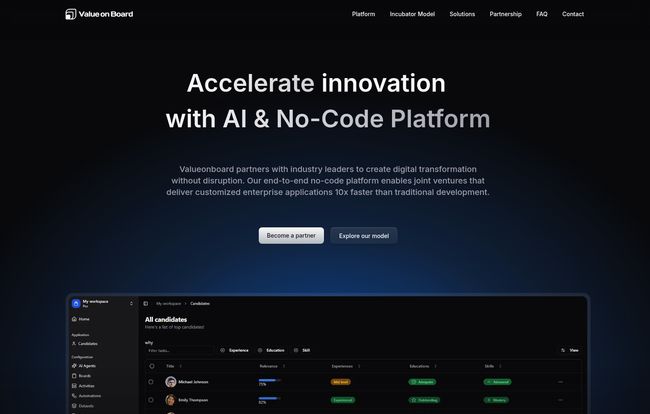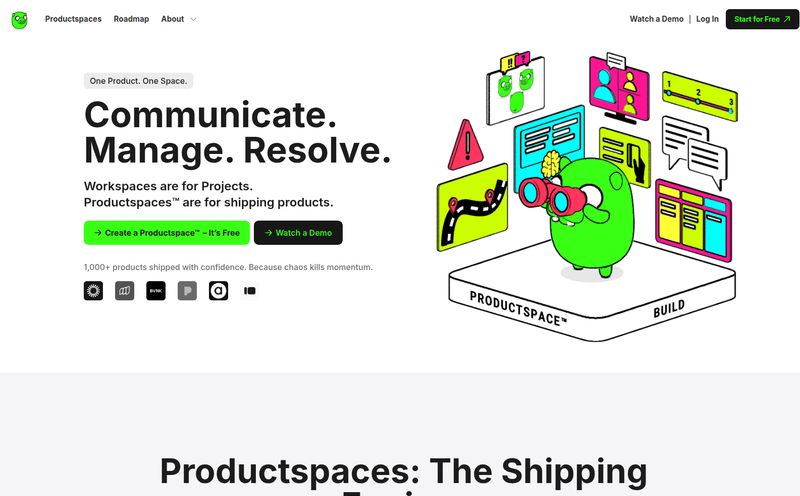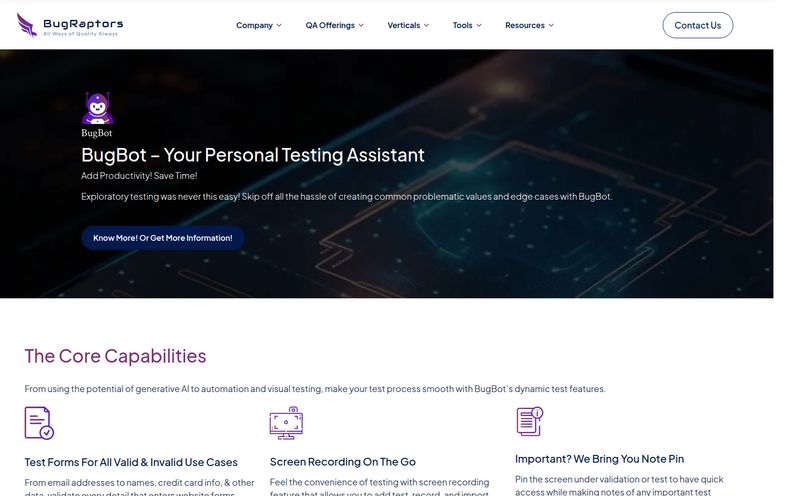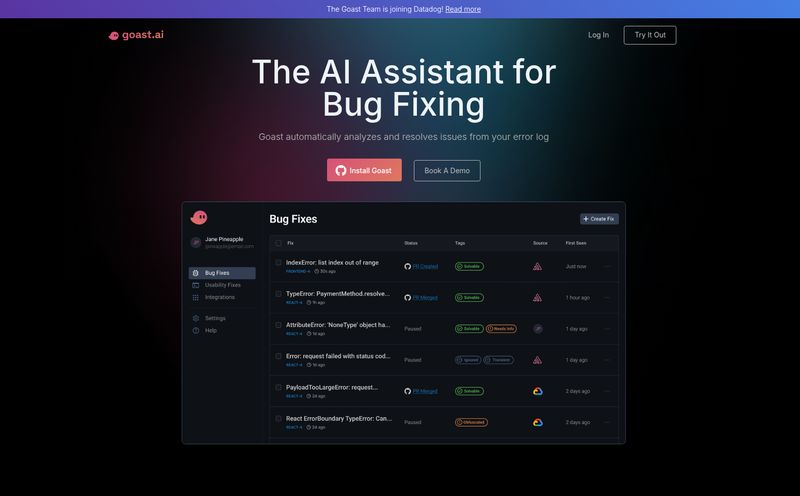Alright, let’s have a real chat. In my years of staring at traffic graphs and dissecting Google's every mood swing, I've seen countless platforms promise to be the “next big thing.” They all sing the same song: faster, cheaper, better. And lately, the hot new chorus is “AI-powered” and “no-code.”
So when Valueonboard landed on my radar, I’ll admit, my initial reaction was a bit of a weary sigh. Another one? But then I started digging, and I realized… wait a minute. This isn't just another tool in the shed. It's a whole different kind of workshop.
They’re not just selling you a platform; they’re proposing a partnership. A joint venture. And that, my friends, changes the entire game.
So, What Exactly is Valueonboard?
On the surface, Valueonboard looks like a slick, modern no-code platform. It lets you build complex enterprise applications without writing lines and lines of code. Think internal dashboards, management systems, and specialized industry software. And yes, it’s got AI baked in, leveraging ChatGPT to help automate workflows and analyze data. So far, so 2024.
But the secret sauce isn’t the tech itself, as cool as it is. The real story is their Innovation Incubator Model. Instead of you paying a hefty subscription fee and being left to your own devices, Valueonboard partners with you. They want to create a joint venture to build, market, and scale a new software solution together. It’s less “here’s the tool” and more “let’s build a business.”

Visit Valueonboard
The "Innovation Incubator" Model Explained
I’ve seen so many brilliant industry experts—people who know their niche inside and out—fail at digital transformation. They have the idea, the knowledge, the contacts. What they don’t have is a hundred grand to drop on a custom software build or the time to manage a team of freelance developers. This is where Valueonboard’s model gets interesting.
Think of it like this: you’re a world-class chef with a revolutionary recipe (your industry expertise). Valueonboard doesn't just sell you a state-of-the-art oven (the no-code platform); they offer to co-own the entire restaurant with you. They bring the kitchen, the front-of-house staff (marketing and sales), and a streamlined process for getting the doors open fast. You bring the secret recipe and the culinary vision.
Their value creation process is broken down into four pretty clear stages:
- Prototype Development (1-2 Weeks): This is incredibly fast. They get a working model in your hands to see if the idea has legs.
- Market Validation (2-3 Months): Together, you test the waters. Does the market actually want this? This step alone can save companies from disastrously expensive missteps.
- Product Development (4-6 Months): Now you build the full-fledged application based on real feedback.
- Scaling & Exit (6+ Months): This is where the joint venture part really kicks in. You work together to grow the user base and create a profitable, scalable revenue source.
This structure de-risks the whole process. You’re not just a customer; you're a partner with skin in the game, and so are they. It's a fundamental shift from the traditional SaaS model.
Breaking Down the Features and Benefits
Going Beyond No-Code Development
Let’s be honest, the promise of no-code has always been speed. Valueonboard claims a faster development cycle that takes weeks, not the typical 6-12 months of traditional developement. For any business, time is money, and being first to market with a new digital solution is a massive competitive advantage. By using a pre-built platform base, they skip a lot of the foundational grunt work and get straight to building the features that deliver value.
The AI-Powered Intelligence Factor
“AI-Powered” is plastered everywhere these days, but what does it mean here? According to their site, it's about Intelligent workflow automation and Data-driven decision and analysis. In plain English, that means the systems you build can automate tedious tasks and, more importantly, help you spot trends and make smarter decisions from the data you’re collecting. For example, their Intelli-HR success story mentions AI-driven candidate screening. That’s a tangible benefit that saves real time and improves hiring quality.
Let's Be Real: The Pros and Cons of This Model
This all sounds great, but as a seasoned SEO and business strategist, I know there's no such thing as a free lunch. Every model has its trade-offs.
| The Upside | The Potential Downside |
|---|---|
| Insanely Fast Transformation: You can go from idea to a scalable software product in under a year. That’s unheard of for most companies. | It's a Marriage, Not a Fling: Success is entirely dependent on collaboration. If the partnership sours, the project goes with it. |
| Shared Risk, Shared Reward: You’re not shouldering the entire financial and technical burden of development alone. This opens the door for innovators who aren't tech giants. | Potential for Dependency: Your new business line is built on their platform. Migrating away would likely be difficult, if not impossible. You need to trust their roadmap. |
| Access to Expertise: You get a tech, marketing, and sales team that is financially motivated to see your joint product succeed. Their success is your success. | Reliance on Your Knowledge: The model leans heavily on the partner’s (your) industry expertise. If your insights are off, the product will be too. |
Who is This Really For?
Let's get one thing straight: Valueonboard is not for the startup kid in a garage who wants to build a simple app. It’s also not for the massive corporation that already has a 200-person in-house dev team.
The sweet spot seems to be established industry leaders and subject matter experts. Think of a successful consulting firm that has a unique methodology, a healthcare group with a proven patient management process (like their Clinic Management System case study), or a recruitment agency with a secret sauce for finding talent. These are organizations with deep, valuable knowledge that is currently analog. Valueonboard provides the mechanism to turn that proprietary knowledge into a scalable, revenue-generating software product.
The Elephant in the Room: What's the Price?
You’ve probably noticed the conspicuous absence of a “Pricing” page on their website. And that makes perfect sense. How do you put a price tag on a joint venture? There is no simple '$99/month' plan here.
The “cost” is going to be a negotiation. It will likely involve some combination of shared investment, revenue sharing agreements, and maybe even equity in the new joint entity. This is enterprise-level deal-making, tailored to each specific partnership. While it lacks the transparency of a SaaS model, it reflects the bespoke nature of the relationship they’re offering. You’re not buying a product; you’re entering a business partnership.
My Final Take: A Bold Move or a Risky Bet?
I have to say, I'm intrigued. In a world of copycat SaaS tools, Valueonboard’s model is a genuinely different approach. It’s a high-stakes, high-reward proposition that directly tackles the biggest hurdle for non-tech companies: turning deep industry knowledge into a scalable digital asset.
Is it risky? Of course. Any joint venture is. You have to be incredibly careful about who you partner with. But for the right company—one with a proven, valuable process and the ambition to build something new—this could be a powerful accelerator. It’s a way to leapfrog the competition without having to become a full-blown software company overnight.
This isn't a tool for building a simple internal dashboard. This is a platform for building a new business. And that’s a distinction that makes all the difference.
Frequently Asked Questions
- 1. What is Valueonboard's joint venture model?
- Instead of a standard client-vendor relationship, Valueonboard forms a strategic partnership with industry experts. They jointly develop, market, and scale a new software application, sharing the risks, investments, and potential revenue.
- 2. Is Valueonboard just another no-code platform?
- No. While it uses a no-code, AI-supported platform as its foundation, its primary offering is the partnership model. The technology is the vehicle, but the business model is the engine.
- 3. Who is the ideal partner for Valueonboard?
- The ideal partner is an established business or expert with deep, proprietary industry knowledge that can be translated into a unique software solution. They bring the “what,” and Valueonboard brings the “how.”
- 4. How does Valueonboard integrate AI?
- It uses AI, including ChatGPT support, primarily for intelligent workflow automation and data analysis. This helps make the applications built on the platform more efficient and capable of providing actionable insights to users.
- 5. Why isn't there a public pricing plan for Valueonboard?
- Because their offering is a partnership, not a standard product. The financial arrangement (the 'price') is customized for each joint venture and likely involves revenue sharing, shared investment, or equity, rather than a simple monthly fee.
- 6. How fast can a solution be developed?
- According to their process, a functional prototype can be ready in 1-2 weeks, with a market-ready product developed in 4-6 months. The entire process from idea to scaling is designed to happen in well under a year.
Reference and Sources
- Valueonboard Official Website
- Forbes: The Rise Of No-Code And The Future Of Software Development
- Harvard Business Review: Collaborate with Your Competitors—and Win (discusses principles of strategic alliances and joint ventures)



